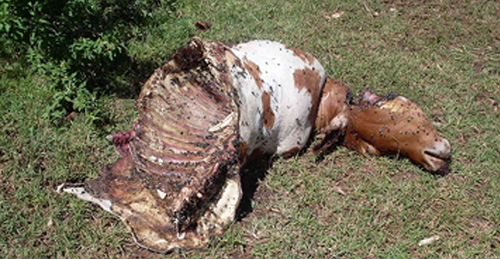
Probably both.
The organization’s warning followed an incident in late April where three lions were poisoned in Lemek, a private wildlife conservancy north of Kenya’s famed Maasai Mara game reserve.
Wildlife officials arrested the alleged killer, a Maasai herder, who admitted the poisoning and showed wildlife officials the powder he used. He explained that the lion had been killing his cattle.
Lion have been killing Maasai stock for aeons. And in the old days Maasai morani would spear the lion to death and that usually did the trick. Today, pesticides have replaced spears. In this case, pending chemical analysis, wildlife officials believe the poison was carbofuran – widely available in Kenya because it’s used in the cut-flower industry.
Unlike spearing the marauding lion, pesticides laid out for the intruder end up killing the whole pride, and that’s what seems to have happened in this case. In the old days, the speared (usually) male lion traumatized the pride enough that they left the area. Now, there are no lions left to leave.
Killing wildlife in Lemek is a violation of two laws: a federal law against killing lions (that allowed federal officials, the KWS, to become involved) and a business contract with tourist camps in the area.
So the alleged culprit was arrested and arraigned, but later released. Not on bail, but because “a local politician intervened on his behalf,” according to Wildlife Direct.
Don’t get too angry.
Wildlife/human conflicts are on the rise throughout Africa and I don’t believe they are being properly handled. In Kenya a number of initiatives are underway, including KWS programs to educate herders and farmers on the importance of wildlife; in Tanzania more aggressive actions are being funded by organizations like AWF to actually fence portions of farms against intruders as large as elephant.
But as human populations develop and their needs become greater, and particularly during an economic downturn and following a drought, these initiatives can actually exacerbate not solve the problem.
Lemek is an excellent example. This is too far away from the real wilderness of the Maasai Mara, an extension of a “private reserve” because of presumed tourist interests. Many of Africa’s best camps are in private reserves, but I think these private reserves have become too far out.
This is really an area that should be left to stock grazing, and what the Kenyan government and wildlife officials should realize is that trying to expand it for tourism is a bad idea. It should be developed for agriculture.
Lions should not be protected in this area. They should be confined to areas further towards and actually inside the reserve, and if motivated to move out into these areas, they should be picked up or shot by wildlife officials before such messy and uncontrollable acts of poisoning grow widespread.
Protecting them in areas like these just increases the problem.
I have a group, that is interested in providing water wells in Maasai land. Let me forward to you their email and the information to proceed. It would be a start. 440 247 3339
As far as what Richard Leakey’s is putting forward, it is clear what needs to be done. With vast areas of land within the country which is deprived of natural rainfall, these animals go beyond their territory or grazing grounds/ feeding grounds and therefore class with man. The story doesn’t begin there, In the late 1800s during the Kenya Uganda Railway, the man eaters (lions) were on the fore front killing anyone who could come near them or even while crossing their territory. In the light of the above, you find that there were plenty of lions to shoot and plenty still remained. those who had to kill lions to be initiated into the clan had to so so as a tradition. but with the emerging order of animal protection and animals being extinct, people have to realize that traditions and norms have to be considered as a way of life.
The government has all the right to protect its wildlife while the Maasai Moran has all the right to defend its property, family and livestock as without livestock, its the same family which will start begging for food from the government and as a result, there is always no help which might be forthcoming at the time of dire need..
Education of the Maasai is very crucial and its upon the next generation who can play a very crucial role in preserving and protecting the natural habitat and the wild animals. Boundaries have to be made as to what needs to be expected by the people living in these protected or government land. Incentives have to be given to the people affected and above all there has to be protection of the people and livestock of these people so that such cases or incidences s do not happen.
Thanks a lot Dr Richard Leakey for your sharing.
HAVE A NICE DAY AND A BETTER NIGHT
Bob Asklo
Lions need protection now, no matter what the old customs used to be. How can we help the lions and at the same time protect livestock and respect the people? Fences, for one thing. BANNING ALL TROPHY HUNTING is another. Too many rich Americans coming over and decimating Africa’s crown jewels, its wild life, is a bigger problem. And African people posioning their wild life? It’s shameful. Fences and perameters are what is needed. We don’t want to live in a world with NO wild lions.